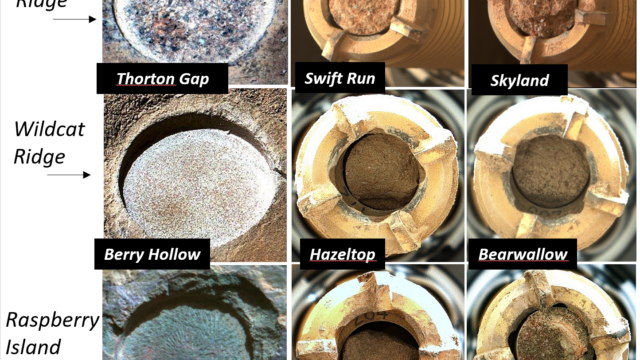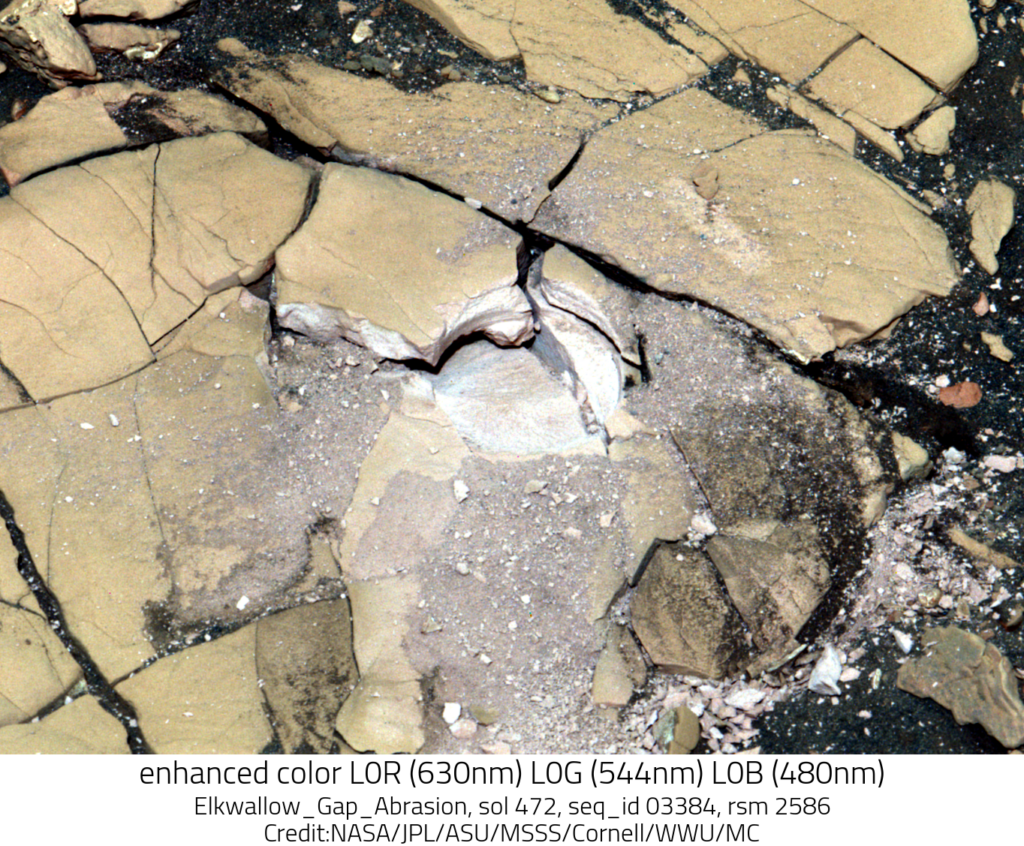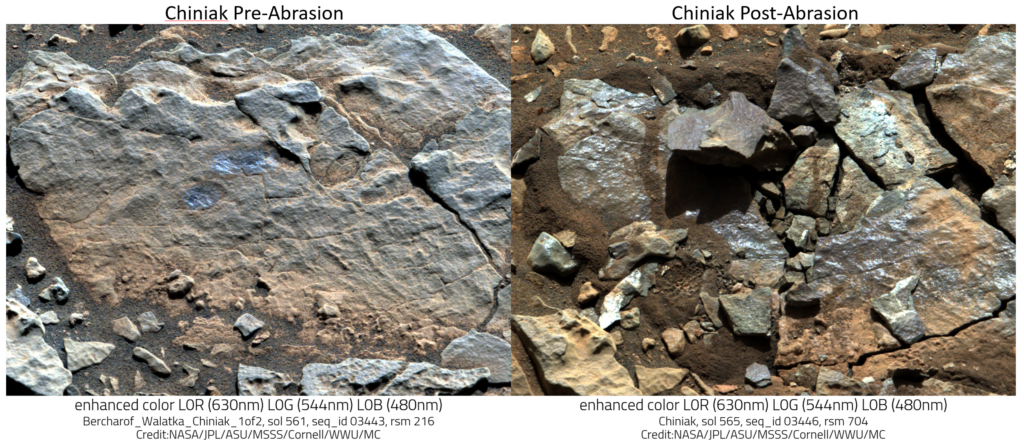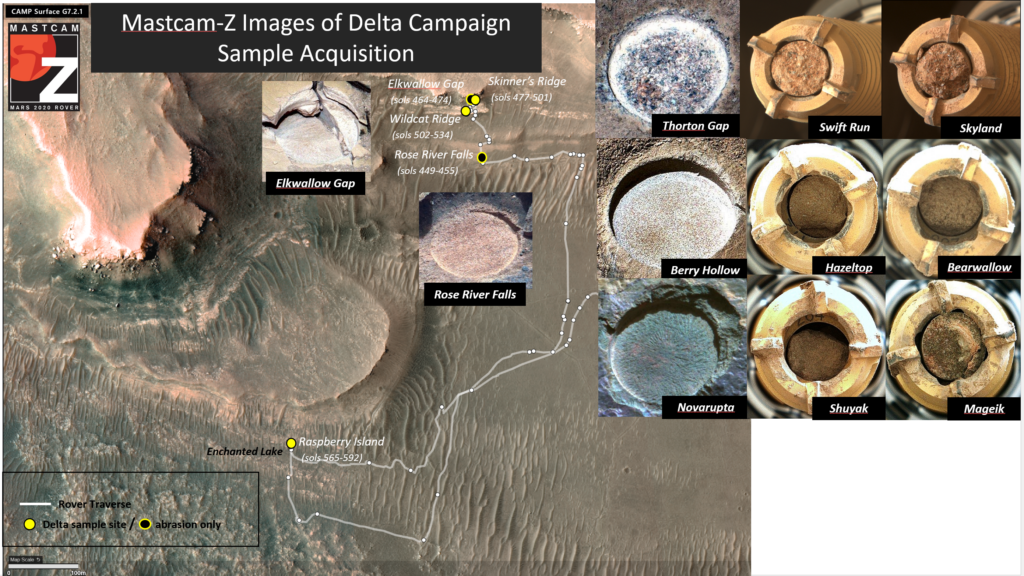
2022-12-21
Sample Cores Part 2: The Delta Edition!
contributed by Alicia Vaughan
Sample collection has wrapped up in the Delta Campaign, and though there was at first some difficulty identifying suitable rocks for sampling, Perseverance has now acquired six samples and assessed five abrasion patches in the layered rocks of the delta stratigraphy! If you need a refresher, Mastcam-Z’s role in documenting sample collection was introduced in an earlier “Sample Cores” blog post.
The first attempt to sample a Delta rock was at a target called Rose River Falls in the Devil’s Tanyard area. But as described in this mission blog post by Lydia Kivrak, the abrasion activity pushed the rock down into regolith, causing so much disturbance to the workspace that it became unsuitable for coring (Figure 1). However, the abrasion patch revealed a fine-grained texture and a pinkish color that is likely caused by the mineral hematite, which was inferred from the spectra from this abrasion.

The second attempt to sample was a little higher on the Delta in a distinctive light-toned outcrop called Hogwallow Flats at a target called Elkwallow Gap. However, as also described in the official mission blog post, the rock fractured during abrasion and was pushed down into regolith indicating again that it would not be competent enough to withstand collection of a sample core (Figure 2). This rock is more fine-grained that Rose River Falls, and though less pink in color, the spectra still show signatures inferred to be associated with the mineral hematite.

As described in this research abstract by Mars 2020 science team members from the 2021 Lunar and Planetary Science Conference, the fine-grained textures of both Rose River Falls and Elkwallow Gap abrasions are representative of a high priority sample to collect in the delta stratigraphy given the depositional environment and potential to preserve biosignatures. After these two attempts, the science team was disappointed, but continued to look for opportunities to collect a fine-grained sample.
Perseverance then moved on to the Skinner’s Ridge outcrop, just beyond Hogwallow Flats, to a block that looked more favorable for sampling to try again. The abrasion patch, Thorton Gap, is consistent with a coarser grained sandstone (Figure 3), and therefore might tell of a different depositional environment than that of Rose River Falls and Elkwallow Gap. This is an important layer for geologists on the team working to reconstruct the depositional history that formed the Jezero Delta layers. Two sample cores were successfully collected from this outcrop: Swift Run and Skyland (Figure 3). Hooray for the first Delta samples!

With these samples collected the science team turned back to Hogwallow Flats to locate a block that might be better for sampling a fine-grained rock from this layer. They identified an outcrop called Wildcat Ridge for the next attempt, and the abrasion patch, Berry Hollow, revealed a very fine-grained rock (Figure 4). As described in this NASA Press Briefing, further investigation of this abraded surface by the PIXL and SHERLOC instruments determined that this rock includes sulfate material and simple organic molecules. Sampling efforts there were successful as well, providing the cores named Hazeltop and Bearwallow (Figure 4). Huzzah!

After sample acquisition activity at Wildcat Ridge, the team identified possible “foreign object debris” (FOD) in the coring assembly (Figure 5). As described on the official mission blog post by Deputy Project Manager Steve Lee, several sols were spent investigating the nature of the material and assessing any potential harm to the system and the safety of stowing the robotic arm for driving away. Mastcam-Z took many images in support of that effort, and ultimately the engineering team declared the vehicle safe to stow the arm and continue its journey.

Perseverance then headed back to the Enchanted Lake area at the base of the Delta, with plans to collect two more Delta formation rock samples and two regolith samples. The first stop was at the Amalik outcrop where the target Chiniak was selected for abrasion. Once again, and as described on the official mission blog by team member Eleanor Moreland, abrasion activities broke the rock and moved material around, making this block no longer a suitable target for coring (Figure 6).

Mission team members quickly identified another promising outcrop located just upslope from Chiniak named Raspberry Island. Here, Perseverance was able to successfully abrade a target named Novarupta and collect the last two rock cores from the base of the Delta, named Shuyak and Mageik (Figure 7). Lots more details on that activity can be found in the official team blog post by team member Stephanie Connell.

Figure 8 shows an overview of the rover’s traverse and the locations where these Delta Campaign samples were acquired.

As the rover wrapped up at Raspberry Island, the team started preparing to collect the first regolith samples of the mission from a nearby ripple (and was successful! See the official team blog post by lead sampling engineer Iona (Brockie) Tirona) before heading off to deposit the contingency sample cache in the Three Forks area!